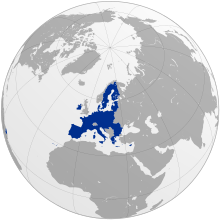
Back Европатәи Аидгыла Abkhazian Еуро Зэкъотыныгъэ ADY Europese Unie Afrikaans Europäische Union ALS አውሮፓ ህብረት Amharic Unión Europea AN Europisce Gesamnung ANG यूरोपीय संघ ANP الاتحاد الأوروبي Arabic ܚܘܝܕܐ ܐܘܪܘܦܝܐ ARC
European Union
| |||||||||||||||||||||||||||||||||||||||||||||||||
|---|---|---|---|---|---|---|---|---|---|---|---|---|---|---|---|---|---|---|---|---|---|---|---|---|---|---|---|---|---|---|---|---|---|---|---|---|---|---|---|---|---|---|---|---|---|---|---|---|---|
| Motto: "In Varietate Concordia" (Latin) "United in Diversity" | |||||||||||||||||||||||||||||||||||||||||||||||||
| Anthem: "Ode to Joy" (instrumental)
| |||||||||||||||||||||||||||||||||||||||||||||||||
 | |||||||||||||||||||||||||||||||||||||||||||||||||
| Administrative centre | Brussels | ||||||||||||||||||||||||||||||||||||||||||||||||
| Largest city | Paris | ||||||||||||||||||||||||||||||||||||||||||||||||
| Official languages | |||||||||||||||||||||||||||||||||||||||||||||||||
| Official scripts[2] | |||||||||||||||||||||||||||||||||||||||||||||||||
| Religion (2015) |
| ||||||||||||||||||||||||||||||||||||||||||||||||
| Demonym(s) | European[4] | ||||||||||||||||||||||||||||||||||||||||||||||||
| Type | Political and economic union | ||||||||||||||||||||||||||||||||||||||||||||||||
| Member states | |||||||||||||||||||||||||||||||||||||||||||||||||
| Government | Supranational and intergovernmental | ||||||||||||||||||||||||||||||||||||||||||||||||
| Ursula von der Leyen | |||||||||||||||||||||||||||||||||||||||||||||||||
| Roberta Metsola | |||||||||||||||||||||||||||||||||||||||||||||||||
| Charles Michel | |||||||||||||||||||||||||||||||||||||||||||||||||
| Formation[5] | |||||||||||||||||||||||||||||||||||||||||||||||||
| 1 January 1958 | |||||||||||||||||||||||||||||||||||||||||||||||||
| 1 July 1987 | |||||||||||||||||||||||||||||||||||||||||||||||||
| 1 November 1993 | |||||||||||||||||||||||||||||||||||||||||||||||||
| 1 December 2009 | |||||||||||||||||||||||||||||||||||||||||||||||||
| 1 July 2013 | |||||||||||||||||||||||||||||||||||||||||||||||||
| 31 January 2020 | |||||||||||||||||||||||||||||||||||||||||||||||||
| Area | |||||||||||||||||||||||||||||||||||||||||||||||||
• Total | 4,233,262 km2 (1,634,472 sq mi) (7th) | ||||||||||||||||||||||||||||||||||||||||||||||||
• Water (%) | 3.08 | ||||||||||||||||||||||||||||||||||||||||||||||||
| Population | |||||||||||||||||||||||||||||||||||||||||||||||||
• 2020 estimate | |||||||||||||||||||||||||||||||||||||||||||||||||
• Density | 106/km2 (274.5/sq mi) | ||||||||||||||||||||||||||||||||||||||||||||||||
| GDP (PPP) | 2020 estimate | ||||||||||||||||||||||||||||||||||||||||||||||||
• Total | |||||||||||||||||||||||||||||||||||||||||||||||||
• Per capita | $45,541 | ||||||||||||||||||||||||||||||||||||||||||||||||
| GDP (nominal) | 2020 estimate | ||||||||||||||||||||||||||||||||||||||||||||||||
• Total | |||||||||||||||||||||||||||||||||||||||||||||||||
• Per capita | $35,851 | ||||||||||||||||||||||||||||||||||||||||||||||||
| Gini (2018) | medium | ||||||||||||||||||||||||||||||||||||||||||||||||
| HDI (2017) | very high | ||||||||||||||||||||||||||||||||||||||||||||||||
| Currency | Euro (EUR; €; in eurozone) and | ||||||||||||||||||||||||||||||||||||||||||||||||
| Time zone | UTC to UTC+2 (WET, CET, EET) | ||||||||||||||||||||||||||||||||||||||||||||||||
• Summer (DST) | UTC+1 to UTC+3 (WEST, CEST, EEST) | ||||||||||||||||||||||||||||||||||||||||||||||||
| (Summer Time in Europe) Note: with the exception of the Canary Islands and Madeira, the outermost regions observe different time zones not shown.[c] | |||||||||||||||||||||||||||||||||||||||||||||||||
| Date format | dd.mm.yyyy (CE) yyyy-mm-dd Date and time notation in Europe | ||||||||||||||||||||||||||||||||||||||||||||||||
| Internet TLD | .eu[d] | ||||||||||||||||||||||||||||||||||||||||||||||||
Website europa | |||||||||||||||||||||||||||||||||||||||||||||||||
The European Union (abbreviation: EU) is a union of 27 member countries in Europe established by the Maastricht Treaty in 1992-1993. It is a sui generis political organisation that has both the characteristics of a federation and of a confederation.
The EU grew out of the European Economic Community (EEC) which was established by the Treaty of Rome in 1957. It has created a common economic area with Europe-wide laws allowing the citizens of EU countries to move and trade in other EU countries almost the same as they do in their own. Nineteen of these countries also share the same type of money: the euro.
The name of Europe comes from the Latin Europa, which in turn derives from the Greek Εὐρώπη, from εὐρύς eurys "wide" and ὤψ ops "face".[11]
The Treaty of Lisbon is the most recent treaty that says how the Union is run. Every member state signed to say that they each agreed with what it says. Most importantly, it says which jobs (’powers’) the Union should do for the members and which jobs they should do themselves. The members decide how the Union should act by voting for or against proposals.
The objective of the EU is to bring its member states closer together with respect to human rights and democracy. It does this with common rules about fair trading with each other, common agreements about law enforcement, a common style of passport, and other agreements. Most members share a common currency (the euro) and most allow people to travel from one country to another without having to show a passport. It does this with common rules about fair trading with each other, common agreements about law enforcement, and other agreements. It has a common style for (its) passports.
- ↑ "European Commission – Frequently asked questions on languages in Europe". europa.eu.
- ↑ Leonard Orban (24 May 2007). "Cyrillic, the third official alphabet of the EU, was created by a truly multilingual European" (PDF). europe.eu. Retrieved 3 August 2014.
- ↑ "DISCRIMINATION IN THE EU IN 2015", Special Eurobarometer, 437, European Union: European Commission, 2015, archived from the original on 14 March 2020, retrieved 15 October 2017 – via GESIS
- ↑ The New Oxford American Dictionary, Second Ed., Erin McKean (editor), 2051 pages, 2005, Oxford University Press, ISBN 0-19-517077-6.
- ↑ Current Article 1 of the Treaty on European Union reads: "The Union shall be founded on the present Treaty and on the Treaty on the Functioning of the European Union. Those two Treaties shall have the same legal value. The Union shall replace and succeed the European Community".
- ↑ "Population on 1st January by age, sex and type of projection". Eurostat. Retrieved 1 February 2020.
- ↑ "World Economic Outlook Database, October 2019". IMF.org. International Monetary Fund. Retrieved 1 February 2020.
- ↑ "World Economic Outlook Database, October 2019". IMF.org. International Monetary Fund. Retrieved 1 February 2020.
- ↑ "Gini coefficient of equivalised disposable income - EU-SILC survey". ec.europa.eu/eurostat. Eurostat. Retrieved 11 December 2019.
- ↑ "Human Development Report 2018 Summary". The United Nations. Retrieved 19 March 2018.
- ↑ "Where Does the Name Europe Come From?". Encyclopedia Britannica. Retrieved 2021-04-11.
<ref group=lower-alpha> tags or {{efn}} templates on this page, but the references will not show without a {{reflist|group=lower-alpha}} template or {{notelist}} template (see the help page).
